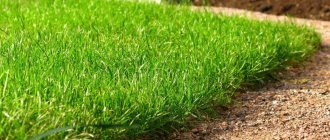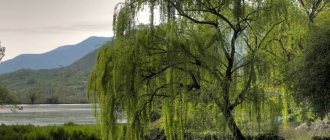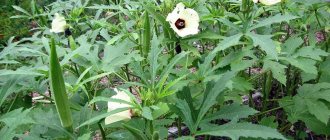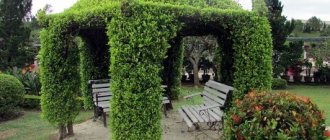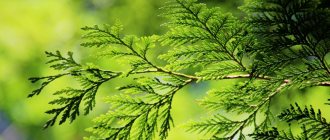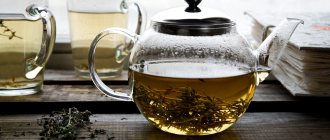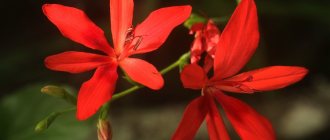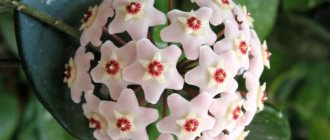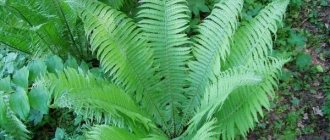Mighty walnut trees more than once provided travelers with protection and food, for which the people lovingly called them the king of nuts. Beautiful deciduous trees of the walnut family are represented by walnuts and are widespread throughout the southern regions of the Russian Federation and the CIS. Their plantings decorate roadsides and accompany travelers on long trips; individual representatives grow in the courtyards of residential areas of cities and, of course, are present in every dacha. However, the distribution area of the walnut is limited to the southern region and repeated attempts to promote the culture to the north ended in failure.
Manchurian walnut tree. © Grijsz Hans
But for the nut lovers of the cold northwest, there is a solution. You can grow not walnuts, but Manchurian nuts, which have the same properties and fruits, but are distinguished by high frost resistance. Long-term frosts of 30 degrees and shorter periods of 45 degrees do not damage mature trees.
Manchurian walnut , or Dumbey walnut (Juglans mandshurica) is a species of deciduous monoecious trees or shrubs of the genus Juglans, family Walnut (Juglandaceae).
Biological description of Manchurian nut
The Manchurian walnut is similar in appearance to the walnut, but there are also distinctive features. The leaf blade is also complex, imparipinnate, but larger than that of the walnut, reaches a length of up to 1 m, contains 7-19 smaller leaflets (10-20 cm in length), jagged along the edge, with a pointed tip.
The nuts are located on branches in 2-7 pieces, smaller than a walnut, with a very dense shell, oval-pointed towards one end. The young bark is light gray, smooth, darkens with age and becomes black in places. When planting seedlings, the first harvest is formed in the 4th year, and with seeds - in 7-8. The first 20-30 years it grows very quickly. The annual growth, especially in the first years, is up to 2 meters.
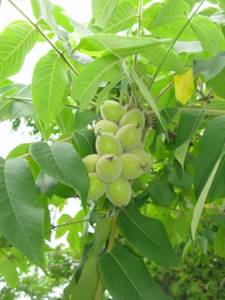
Manchurian nut fruits. © Qwert1234
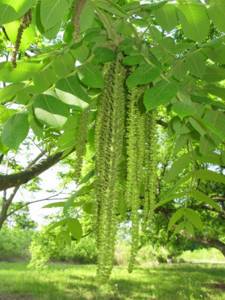
Male flowers (catkins) of Manchurian walnut. © Qwert1234
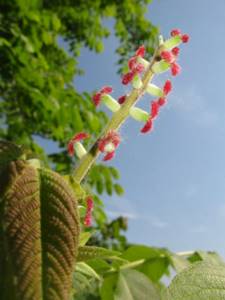
Female flowers of Manchurian walnut. © Qwert1234
Manchurian walnut is a monoecious plant that produces separate male and female flowers. The male ones, in the form of long black earrings, bloom simultaneously with the buds opening. Female, represented by few-flowered small racemes. They are pollinated by the wind. Flowering occurs in April-May. The Manchurian nut harvest forms in 1-2 years. When the leaves turn yellow, the fruits are suitable for harvesting (2-3 days of September).
The genus and its representatives
Olga Nikitina
The genus Walnut (Juglans) belongs to the walnut family and has about 40 species, widespread in temperate and subtropical regions of the Northern Hemisphere. These are large deciduous trees with pinnately compound leaves, reaching 1 m in length in some species. The crown is spreading, formed by powerful branches. Male flowers are collected in long multi-flowered earrings located at the base of young shoots, female flowers are single or 2-3 at the ends of the shoots. The fruit is a false drupe (colloquially called a “nut”), the seeds are covered with a green shell, which is formed from bract scales and petioles of rudimentary leaves. The fruits have a pleasant taste and nutritional value, since their kernels contain up to 80% fatty oil. In terms of nutritional value, they are superior to meat, eggs, milk, and chocolate. The leaves and shell of the fruit contain large amounts of vitamin C.
The wood of the nuts is dense, durable, brown-brown in color, with clear growth rings. It is used in the manufacture of expensive furniture, gun stocks, and keyboard musical instruments; burl wood is especially valued.
Most types of nuts grow quickly and are demanding on soil fertility and moisture. The root system is deep and taprooted, so transplantation is poorly tolerated. They suffer from strong winds, during which large leaves are damaged - and the plants do not look very attractive.
The nut is most often propagated by sowing seeds in the spring, since during autumn sowing the nut drupes are damaged by rodents. Decorative forms and varieties are propagated by grafting.
When planting in groups, the distance between plants should be at least 5 m. Humus, wood ash or phosphorus-potassium fertilizers are added to the planting hole; the optimal soil acidity is pH 6.5–7.5. After planting, the soil is watered abundantly and the tree trunk circle is mulched. Nuts need a sufficient amount of moisture in the first half of the growing season (during the period of growth and flowering) and its reduction in the second half of summer. During the dry period, watering is carried out 1–2 times a week at the rate of 1.5–2 buckets for each tree.
Dried branches or branches that thicken the crown are cut out of nuts; it is better to do this in the spring.
Most types of nuts grow quickly and are demanding on soil fertility and moisture. The root system is deep and taprooted, so transplantation is poorly tolerated.
Walnut (J. regia) grows naturally in the mountains of Central Asia, Western Georgia, Asia Minor and Afghanistan.
This is a powerful tree with a height of 30–35 m and a trunk diameter of up to 2 m. The crown is dense, spreading, tent-shaped. The leaves are imparipinnately compound, consist of 5–11 leaflets, the upper one is the largest, on a long petiole, the rest are sessile.
After the fruit ripens, the shell cracks, the shell has smooth edges, and the cotyledons are well developed. There are many varieties of o. walnuts, differing in size, shell thickness and fruit shape: thin-barked, hard-shelled, dessert, almond-shaped, racemose, large-fruited, etc. There are trees with burl growths, the wood of which has a beautiful pattern and is very much valued.
Manchurian walnut (J. mandshurica) grows naturally in the Far East, Korea and Northern China, where it does not form pure stands.
A tree up to 25 m high with thick branches and huge meter-long leaves. The crown is highly raised, wide-rounded, openwork. The trunk is straight, covered with dark gray, almost black, deeply furrowed bark. The fruits are small and, when ripe, hang in whole garlands (5–10 pieces or more) from the branches of the tree. The fruit shell is very hard, the cotyledons are small, and the taste is low.
In the conditions of central Russia it is winter-hardy, however, in the spring the blossoming leaves suffer from frosts, but the shoots and crown quickly recover.
Siebold's nut , or ailantholicum (J. sieboldiana), is common in the Kuril Islands, Sakhalin and in the mountain forests of Japan.
This is a tree up to 20 m high with a loose tent-shaped crown. The trunk is covered with greenish-gray bark. The leaves are large, odd-pinnate, with a brownish petiole. The fruits are round or ovoid, with a sticky surface, collected in hanging clusters of up to 20 pieces. A nut with a rounded base and a sharp tip, the cotyledons are pleasant to the taste.
It grows quickly, is winter-hardy, and is less demanding on soil richness than previous species.
Heart-shaped walnut (J. cordiformis) naturally grows in the deciduous forests of Japan, where it reaches a height of 15 m, in central Russia - no more than 10 m. The crown is loose, tent-shaped. The leaves are imparipinnately compound, up to 1 m long. The drupe fruits are small, 3–4 cm long and up to 3 cm wide, heart-shaped, with an elongated apex, smooth on the outside and without partitions inside. In terms of taste, they are considered the best nuts that can be grown in the Moscow region.
It is winter-hardy, grows quickly, and begins to bear fruit early and abundantly.
Gray walnut (J. cinerea) grows in the Atlantic states, mainly in broadleaf and coniferous forests.
Tree up to 30 m high and trunk diameter up to 1 m, tent-shaped crown. The trunk is covered with gray, deeply furrowed bark. The leaves are large, odd-pinnate. It is considered a long-lived species, living up to 200 years. Less demanding on soils than o. walnut and o. black, and not as moisture-loving as Fr. Manchurian. Forms frost-resistant hybrids with o. walnut, o. Manchurian, o. Siebold.
Black walnut (J. nigra) grows naturally in North American broadleaf forests and mountains on fertile and moist soils, where it reaches a height of 50 m and a diameter of 1.5 m.
Forms a wide spreading low crown. The leaves are imparipinnate, but the poorly developed upper leaf gives the false impression that the leaves are pippinnate. The fruit is spherical, covered with a black shell.
More shade-tolerant than o. gray, but inferior to it in terms of frost resistance, so it feels better in the southern regions.
The nut is most often propagated by sowing seeds in the spring, since during autumn sowing the nut drupes are damaged by rodents. Decorative forms and varieties are propagated by grafting.
Walnut Black walnut Gray walnut Heart-shaped walnut Manchurian walnut, men's earrings Manchurian walnut with fruits
Positive qualities of Manchurian nut
- Nut kernels containing more than 50% fat are used fresh for food.
- A very tasty, medicinal jam is prepared from green nuts (at the beginning of June) of milky ripeness (2-3 cm in size).
- A decoction of leaves prepared during flowering is used for gastrointestinal diseases, loose gums, and exudative diathesis.
- Fresh leaves are applied to wounds to prevent rotting. Used to treat furunculosis.
- To cure foot fungus (and even nail fungus), the leaf is brewed like tea. After cooling, the feet are kept in the solution for 20-30 minutes. The procedure is performed within 7-10 days.
- A decoction of the leaves improves the quality of hair (accelerates growth, restores shine, eliminates dandruff).
- Cleans the air well from dust. The plant contains a bactericidal substance, juglone (the smell of iodine), which disinfects the air from pathogens.
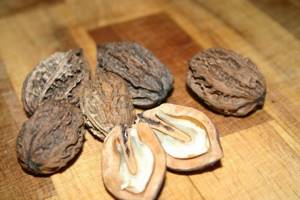
Manchurian walnut
How to propagate Manchurian walnut
On the site, the crop is propagated mainly by seed. The plant is also used for grafting to improve its characteristics.
Manchurian nut grafting
The advantages of the crop include good winter hardiness, rapid growth and abundant fruiting. But there are also disadvantages - the shell of the fruit is so hard that it is almost impossible to crack it.
For this reason, Manchurian walnut is often grafted onto walnut. The latter increases endurance and accelerates growth, the fruits appear already in the 4th year of life and have a good taste. Splitting the shell does not require much effort.
Vaccination is carried out mainly in the following ways:
- copulation;
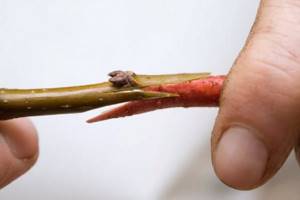
When copulating in early March, the scion and rootstock are connected to each other with oblique cuts and left in a cool room until the end of spring. - budding;
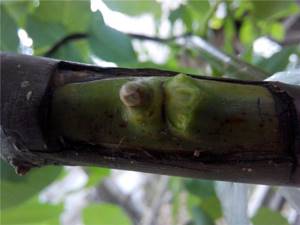
When budding, a Manchurian walnut bud is grafted during the leaf opening period or in mid-summer - ablation.
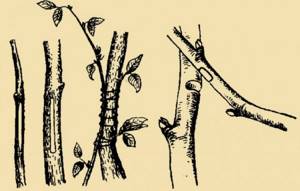
When ablacting, young seedlings are placed side by side and simply spliced together with trunks
Practice shows that Manchurian walnut is grafted onto walnut with difficulty, with an efficiency of 30-40%. According to gardeners, the best results are obtained by the ablactization method.
How to grow Manchurian nut from walnut
When propagated by seed, germination is about 70-90%. First, it is recommended to germinate the Manchurian nut at home and only then transfer it to the ground.
How to germinate Manchurian nut kernels
One-year or two-year-old fruits of the crop are suitable for cultivation; they demonstrate maximum germination:
- Nuts must first be stratified; for this, in November or December they are placed in wet sand.
- The container is placed in a plastic bag with holes made and left in a cool place with a temperature of about 5 °C.
- From time to time the container is checked, re-moistened and excess condensation is removed.
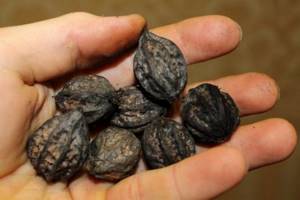
Stratification takes about two months.
How to grow Manchurian walnut at home
In spring, fruits are not immediately transplanted into a container with soil:
- A month before planting, they must be removed from the sand, washed and soaked for 7-10 days in warm water until the shell flaps move apart.
- After this, a layer of wet sawdust or river sand is poured into a shallow but wide container, the fruits are placed on the edge and sprinkled with the remains of the substrate on top.
- The container is kept at 25-28 °C for 10 days. When the emerging roots reach 1 cm in length, the container is again transferred to a cool place with a temperature no higher than 5 ° C until planting in the ground.
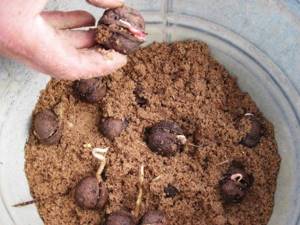
. Important! Planting in separate pots during the germination process is not carried out unless absolutely necessary. The roots of the crop are highly sensitive and can be easily damaged.
Use in decorative design of the site
Manchurian walnut - reaches a height of 10-25 m, is known for the slenderness of the formed trunk and a wide spreading crown. In the northern regions it can grow as a shrub and in this form also produce fruit. Manchurian walnut is a fast-growing ornamental crop.
Thanks to its decorative foliage crown, the walnut fits perfectly into any landscape. Effective for landscaping a summer cottage, both around the perimeter and in a separate limited space. The foliage of nuts releases phytoncides that drive away mosquitoes, so hazel is a wonderful assistant in decorating a relaxation area. Particularly notable for their aesthetics are joint plantings with conifers, decorating trimmed areas of lawns with green clumps.
LiveInternetLiveInternet
Quote from sinichca's message
Read in full In your quotation book or community!
Manchurian walnut instead of walnut
Author: Kazanin Gennady Petrovich, experienced gardener and local historian city: Kemerovo region, Osinniki Source: sadisibiri.hop.ru
Have you ever walked along a small alley on Kirova Street in the city of Osinniki? If you haven't been there, go, look around, breathe. There is a special air there that surprises you at first, because you don’t understand what’s happening to you, where this life-giving fragrance comes from. You will be alarmed by the surprise, and then all petty worries will disappear from your head, you will feel more cheerful and calm, you will want to sit in the shade and calmly breathe in the moist aroma. Where is he from? You look around - there are gray smooth tree trunks all around. If you look up, you can’t see the sky, only a green, thick cobwebby curtain of bright green foliage. This is where this wonderful stream of clean, healthy air falls on us... The Manchurian nut, which is very similar to the walnut, was planted here in the early 1970s. Back then, local residents had little idea of what it would look like in adulthood, so they planted them close to each other. Trees planted sparsely feel better, spread widely in free space, and look more powerful and beautiful. They will argue with the oak tree. And here they raced upward towards the sun, interfering with each other, and at a height of 8-10 meters they closed the crowns and formed a luxurious, fragrant tent. It’s unlikely that anyone would have thought to take advantage of the gifts of the wonderful tree. They don’t even collect the leaves, although they say that the Manchurian nut is “a cure for a hundred diseases,” and in local pharmacies, as they say in the advertisement, a leaf of the nut can be bought for 110 rubles (15 g). If only we knew what wealth hangs over our heads: precious deposits. *** This rare and valuable plant is occasionally found in private plots and Michurin gardens. It is sometimes confused with its close relative, the walnut. However, the walnut, which attracts us with its full-fledged kernel, is impractical to grow in harsh climates; it freezes above the snow cover, although it exhibits the vitality inherent in the genus, each spring producing new powerful shoots from the surviving buds. The most winter-hardy walnut variety, Ideal, planted in my garden in 1997, is preserved only in its creeping form. Today, professional breeders and experienced gardeners are trying to create new valuable varieties based on crossing walnuts with Manchurian walnuts, combining the productivity of the first and the winter hardiness of the second. In the West, nut crops are especially popular. Many gardeners are engaged in the selection and acclimatization of walnuts. Even the American billionaire Henry Ford is said to have developed several varieties. I grow one of the winter-hardy walnut varieties from fruits received in 2009 from Saratov. Another way of fertilization is the search for frost-resistant varieties in areas where the crop traditionally grows. And there are some successes along this path too. However, in our country very little attention is paid to nuts. For now, we are content with products imported from abroad. Only in the mountainous and foothill regions of Altai are there plantings of Manchurian walnut in the form of forest protection belts, and there tens of tons of fruits are uselessly wasted due to the inability to use them. Biologist from Kazakhstan Irina Loginova writes: “The powerful green crown of the Manchurian walnut is capable of trapping dust and gas. The nut releases a special bactericidal substance - juglone, which disinfects the atmosphere. It is advisable to plant all parking lots and underground garages with walnut trees, because the large feathery leaves of the walnut cleanse the air of gasoline vapors, acetylene and other contaminants. It is no coincidence that a program to create walnut groves in the territory affected by the Chernobyl accident is coming into force in Belarus.” So today the Manchurian walnut is the most useful and convenient crop not only for improving the design of our gardens, but also for beautifying and improving the ecology of streets, alleys, and parks in our cities. Moreover, the lifespan of a tree is more than 250 years. Fresh breath can be provided not only for ourselves, but also for our distant descendants. More than once I suggested to the leadership of the city of Kaltan to plant nuts instead of poplars, at least on Komsomolskaya Street. The answer is only silence. In the spring of 2001, I voluntarily planted 125 sprouted nuts along the road from the crossing to the village of Malyshev Log, but the overly diligent utility workers turned the entire edge of the roadside downhill the following winter. Perhaps, by chance, only a few specimens remained alive.
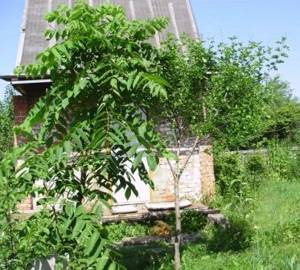
Photo from my garden (Manchurian walnut next to mulberry) Manchurian walnut was planted in front of my garden house porch in 1985. It grew tall, spreading, and began to bear fruit. But in 2004, during a fire, it burned down to the very roots, and the next spring it sprouted several shoots from the roots. I cut out the weak shoots, left one, which grew and is bearing fruit again today. However, I changed the way I formed the tree so that it would not shade neighboring plants and began to cut out all the side growths. As a result, it acquired a palm-shaped shape with a high crown and quickly began to bear fruit. My neighbor A.I. Timofeev inherited from the previous owners a huge walnut tree, which with its spreading crown shaded half of the plot, because no one had ever shaped it. Last year he cut it out at the root. Although you should simply cut off the extra trunks and leave one trunk, cutting off the low-lying side shoots on it. *** What kind of crop is this that enjoys special respect among gardeners, capable of improving the design of the garden, its microclimate, serving as medicine and giving wonderful healthy fruits? Manchurian walnut (Juglans mandshurica Maxim) is a representative of the Far Eastern fauna, a large spreading tree, reaching a height of 25-30 m, can withstand temperatures down to -50°C, has a short growing season, so it can be cultivated in the most climatically unfavorable areas and on different soils. A clear proof of this is that it has taken root very well even in my heavy swamp. The tree is wind-resistant because it has a powerful root system and forms a long taproot, which increases drought resistance. However, in areas with close groundwater, this root still needs to be pruned. The plant has a smooth gray trunk, strong wood with a beautiful solid structure. It is used to make furniture and art products. The leaves are large, reaching a length of 1 m or more. It blooms with long male catkins and small female racemes. Sets 3-7 fruits per cluster. The fruits have a somewhat elongated shape with a pointed apex. In our climatic conditions it ripens by mid-September. It begins to bear fruit in the 6th year from planting, gradually increasing the yield. From one mature tree you can collect 30-40 kg of fruit. In particularly harsh winters, the ends of young shoots may freeze, but this does not in any way affect the general condition of the trees. Walnut leaves are rich in essential oils, alkaloids, phytoncides, carotene, tannins and other beneficial substances. Fresh or dried leaves are used for medicinal purposes. They are collected in June and dried in the shade. Used in the form of decoctions and tinctures to prevent cerebral vascular sclerosis, and also as a general tonic, wound-healing agent. Medicines made from Manchurian nuts improve metabolism, help lower blood sugar, etc. They can also compensate for iodine deficiency in the human body. Although the yield of pure kernel from the Manchurian nut is only 20-30%, its dietary and nutritional properties are priceless. They contain about 55% oil. I eat them fresh and also use them in cooking. But not everyone succeeds in extracting the kernels by destroying the hard shell. But somehow they are splitting things up in China. I personally tried many times to split it with a hammer, mallet, or clamped it in a vice. In any case, the nut crumbled into small fragments, where the shell and kernel were mixed so that you didn’t want to choose. photo by A.I. Makunas In the fall of 2011, a gardener from the village of Altaisky, Anton Ivanovich Makunas, shared with me the secret of an effective method for extracting kernels. Experience came to him as a result of repeated trial and error. He prepares nuts at the end of September; at this time the shell (pericarp) almost completely dries out. Stores in bags in the basement and splits in December, when the fruits dry out a little and the kernel lags behind the walls of the shell. To do this, he takes a large birch log, makes a depression at the end, into which he inserts the fruit with the sharp end. Then he makes several blows with a hammer with a flat head on the back part of the fruit sticking out of the log. The shell and internal partitions are destroyed, but the kernel remains almost undamaged, and getting it out is not difficult. Thanks to the man: I learned it myself and told me. The prevalence of Manchurian walnut in our country is difficult because so far only specialized tree nurseries propagate it, and in private nurseries the cost of a seedling reaches 500-600 rubles, i.e. not affordable for a simple gardener. Moreover, no one guarantees the survival rate of seedlings. Having read abstruse recommendations, I began propagating the Manchurian walnut with complex procedures. I soaked the seeds for four days in a thick solution of potassium permanganate, which allegedly helps to destroy the thick shell, then germinated them in a seedling box and only then planted them in the garden. However, over time, I tried a simpler method - I did the autumn sowing of fruits directly into the ground with a depth of 5-10 cm. The method turned out to be simple and productive. For example, autumn sowing in 2010 gave 100% germination. As they say, the casket simply opened. Walnut trimming and shaping can be done at any time of the year. It easily endures any operation, and as we already know, it easily grows back from the roots even if the root is completely destroyed. It can be formed as a multi-trunked, widely spreading tree, or in a single-trunked palm-shaped form with a high-spaced spherical crown that does not shade other plants located on the site. In folk medicine, Manchurian nut has been widely used from ancient times to the present day. There are a lot of publications on this topic in various publications and on Internet sites. “A decoction of leaves and pericarp is used for stomach catarrh, diarrhea, rickets, and exudative diathesis. Recipe: 20 g of crushed leaves pour a glass of boiling water, leave for 20-30 minutes and drink a tablespoon 3 times a day. A tincture of leaves is used to rinse the mouth when loosening the gums. Leaves are applied to wounds and boils. In homeopathy, preparations from the pericarp and leaves are used as mother remedies. And to keep your feet clean, just soak 1 leaf of Manchurian nut in hot water for 20-30 minutes, and when the water cools down, pour it into a basin and keep your feet in this water for at least 20 minutes. Repeat the procedure for a week. The fungus will disappear, no need to go to the pharmacy or spend money on medicine. It has long been known that there are countless skin diseases in humans. You can also rinse your hair with a decoction of the leaves after washing to get rid of dandruff and improve the quality of your hair.” (Ivanova Tamara Georgievna, forestry engineer, Ulyanovsk). “Many types of drugs are prepared from the leaves of the Far Eastern nut to cure various forms of cutaneous tuberculosis - warty skin tuberculosis, tuberculous lupus, scrofuloderma and others. Also, eczema, lichen, purulent rashes and many other skin diseases are treated with infusion and decoction of Manchurian walnut. Fresh Manchurian walnut leaves do an excellent job of cleansing and healing boils and wounds, and help avoid painful calluses (they rub your hands until they turn brown). Externally used in the treatment of certain gum diseases and reduce bleeding. Walnut decoction helps with stomach catarrh, rickets, diarrhea and exudative diathesis. Manchurian walnut decoctions, when used externally, are an ideal hemostatic and blood purifying agent. If you have a sore throat, it is recommended to gargle with a warm decoction of dry leaves. In folk medicine, it guarantees the relief of unimportant, unpleasant sensations. After prolonged soaking, unripe fruits are used to make jam. They say that it is very tasty and nutritious. True, I haven’t tried it myself. You can make jam like this: “Remove the skins from green nuts, boil five or six times for 15 minutes, constantly changing the water; then you need to rinse them several times with cool water, after which you should soak them for five or six hours. Pour nuts into the syrup prepared in advance and cook until tender. Add vanillin before removing. Proportions: half a liter of water, 100 nuts, 1 kg of sugar and two pinches of vanillin.” The wound healing agent is prepared as follows: 50-60 g of fresh nut leaves are infused in 300 g of sunflower (olive) oil for about two weeks. It turns out to be an ideal oil tincture; it is recommended to lubricate damaged areas or use it as a compress. Pour 20 g of chopped leaves into a glass of boiling water, leave for 20 minutes and drink a tablespoon 3 times a day, this is perfect for treating diarrhea, rickets, diathesis and stomach catarrh. The same infusion is used to rinse the mouth for loose and inflamed gums. Walnut leaves are applied to boils and wounds. Baths made from the walnut bark of young shoots are used for rheumatism and skin diseases. Bast is used as an analgesic and wound-healing agent.” (Site https://blogotshelnika.ru) “With the help of Manchurian nut tinctures, the immune system is also boosted. To do this, you need to grind 40 nuts, mix with honey and pour in a liter of moonshine. In 40 days in a dark place it will turn into a nourishing tincture. In order to take 1 tbsp. spoon 30 minutes before meals - first you need to strain it all. For the same purposes, add a few drops of another tincture to the tea. To prepare it, you need to add 600 g of ground unripe nuts to a kilogram of sugar. Leave in a dark place in a three-liter jar for 30 days. During this time, the mixture must be stirred occasionally directly in the jar.” (Site https://ecovoice.ru/). Manchurian walnut enhances garden design. In addition, this very useful culture in all respects will definitely take root in our gardens and on the streets of our cities. You just need to form the tree correctly.
How to grow Manchurian walnut at home
Manchurian nut is a light-loving crop, not afraid of winds, but sensitive to drought. Propagated by fruits and ready-made seedlings. You can purchase seedlings from trade organizations that sell planting material. It is not advisable to buy seedlings from random sellers.
Propagation by seedlings
Walnut seedlings are difficult to tolerate transplantation. Therefore, when you decide to propagate a crop vegetatively—by planting seedlings—you need to immediately select a suitable location. Nuts are among the crops that like to grow with an open head. The place, therefore, should be sunny, not shaded by tall trees. Walnut grows well in low places, but the soil must be fertile. Given the deeply penetrating root system with a large branched root, seedlings should be planted away from buildings. If several trees are planted in a row, then holes for seedlings are marked every 10-12 m.
Planting of seedlings can be done in September or April. We prepare a planting hole with a depth of at least 80-100 cm and a volume equal to the root system of the seedling. We lay drainage at the bottom of the hole, under which you can use broken brick, crushed stone and other material. Place a layer of soil to cover the drainage and part of the planting hole.
If the soil is depleted in nutrients or dense clay, then prepare a planting mixture. Mix the top layer of soil in the planting pit with humus, turf and sand in the appropriate parts 4:2:2:1. Add 20-40 g/pit of superphosphate and potassium fertilizer. Instead of potash fertilizers, you can add a glass of wood ash. Mix the prepared mixture well.
We inspect the seedling (1-2 years old), shorten the central root. Place it in the center of the hole and immediately tie it to a peg. We partially fill in the soil mixture, carefully fill a bucket of water and, after absorption, add the rest of the soil and press it around the trunk. Add another 0.5-1.0 bucket of water. We mulch the soil around the trunk with peat, sawdust (not pine), mature compost, and healthy foliage.
For the winter, we insulate the seedlings, since at a young age the tips of the branches can freeze. For insulation, we wrap the trunk and lower branches with burlap or non-woven material and protect it from rodents with a net. We dig the mesh into the ground and trample it around. In winter, after snowfalls, we repeat the procedure so that mouse-like rodents do not make passages in fresh snow.
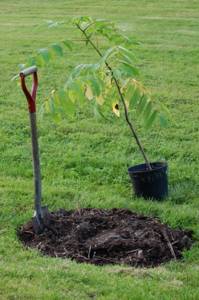
Manchurian walnut seedling. © Chika Oka
Propagation by seeds
When a nut is propagated by seeds, the positive qualities of the parent tree are not always transferred to the new plant. For propagation by seeds, 1-2 year old nuts are used. Starting from the 3rd year of storage, seed germination sharply decreases. Seeds can be sown in spring and autumn. It is more advisable to plant nut fruits in winter. In this case, stratification is not needed and seedlings appear much earlier than during spring planting.
To plant hazel seeds, select a well-drained fertile area, water it thoroughly, and form a bed. Walnut does not tolerate acidic soils, so we add 2-3 cups of wood ash per 1 square meter. m and dig to a depth of 10-15 cm. We make holes 6-8 cm deep at a distance of 8-10 cm. Dip the nuts intended for planting in kerosene to prevent the ubiquitous mice and other rodents and place them in the holes on the edge. We fill it with soil and mulch on top with any materials to maintain moisture. Being in natural conditions, the nut fruits undergo stratification and powerful shoots appear in the spring.
Seedlings can be immediately transplanted permanently, after pinching off the central tap root. You can leave it in place for the first year and plant it permanently in the fall in August, not forgetting to shorten the central root. This operation stimulates the growth of the crop. When replanting a sprouted nut or seedling, you must immediately determine its permanent location.
How to plant Manchurian walnut
The fast-growing Manchurian nut is transferred to the garden in the first year. If you choose the right place and prepare the soil, the crop will take root without problems.
Recommended timing
When germinating from seeds at home, the fruits are planted in the ground in the spring, after the ground has completely thawed. You can also root them in the garden in the fall. In this case, preliminary stratification is not needed; the fruits are buried in the soil and wait for spring shoots.
Site selection and soil preparation
It is recommended to plant Manchurian walnut in a spacious and well-lit area with light shading. The soil should be fertile and moist, but not swampy. It is necessary to monitor the acidity of the soil; the pH level is required to be neutral or slightly alkaline:
- Shortly before planting, the site is dug up to a depth of 50 cm and the weeds are uprooted.
- If you plan to transfer sprouted fruits into the ground, then prepare shallow holes for them. For a grown seedling, you need to dig a hole about 0.5 m deep and 0.6 m wide.
- A layer of broken brick or crushed stone is poured onto the bottom, and then the hole is half filled with a soil mixture of turf and humus with the addition of complex mineral fertilizers. A stake is driven into the center of the hole for the seedling, which will serve as a support, and the area is generously spilled with 3 buckets of water.
Advice! When planting several specimens at the same time, you should leave 5 m of space between them, otherwise the trees will quickly begin to interfere with each other.
How to plant Manchurian walnut correctly
The algorithm for planting Manchurian walnut depends on what kind of material is to be used:
- For germinated seeds, prepare small holes about 10 cm deep. As a rule, 3 nuts are placed in one hole at once, and then the excess seedlings are removed, leaving only the strongest. You can use a temporary bed, or school, then the fruits are planted 10 pieces per 1 meter, and in the fall the grown trees are transferred to a permanent place.
- If we are talking about a strong seedling, then before planting it in a hole prepared in advance, its underground part is moistened with water, and the damaged areas are removed. The plant is carefully placed on a mound of soil mixture inside the hole, filled with soil to the end and the trunk circle is compacted. The seedling is tied to a support peg and watered abundantly, and then mulched with humus.
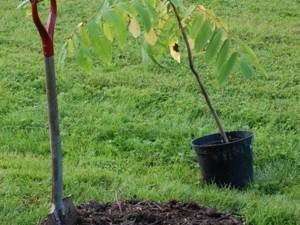
. Important! If the Manchurian nut is supposed to be placed first in a temporary area, then it must be transferred to a permanent place in the first year of life. The root grows very quickly and may be damaged if transplanted too late.
Manchurian walnut care
When permanently replanting a seedling or a mature sapling, try to maintain the original location of the young plant relative to the parts of the world, which will allow it to take root faster. Walnut is a moisture-loving plant and therefore the soil must be kept constantly moist in the first year.
We water 2-3 times a month without flooding the soil. In years 2-3, we reduce the frequency of watering to 5-7 times, and in subsequent years, watering in the summer season is carried out once a month. After watering, be sure to loosen the soil, simultaneously destroying weeds, and mulch. In the 4th year the tree blooms and can produce its first harvest.
During this entire period, caring for young trees includes fertilizing with phosphorus-potassium fertilizers, which are applied once during the growing season, preferably during the period of fruit formation (June). You can only fertilize with superphosphate, but be sure to add a glass of wood ash, which contains a large set of macro- and microelements necessary for the normal development of the crop.
Trees need annual digging at the level of the edges of the crown. Mature trees can tolerate short-term drought and temporary flooding of the root system. To protect young trees from sunburn, do not forget to regularly clean the trunk and skeletal branches with lime mortar with the addition of clay and adhesive. If agricultural practices are followed, trees are practically not affected by diseases and pests.
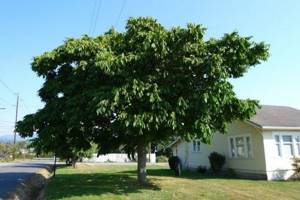
Manchurian walnut tree. © T. Abe Lloyd
Pests and diseases of Manchurian nut
Looking at the photo of mature giant Manchurian walnut trees, it is difficult to imagine that some insects could damage it. The culture as a whole is unpretentious and resistant to diseases.
Excessive moisture can cause the development of a fungal disease - black spot. The plant should be immediately treated with antifungal drugs, immediately reduce watering and loosen the soil for faster drying.
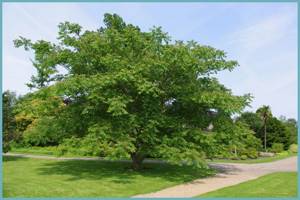
When pests appear, use insecticides to control them.
The tree can be damaged by gall mites and gall mites, which can be controlled with the help of special preparations.
The powerful Manchurian walnut tree decorates the garden, produces tasty and very healthy fruits, and valuable wood.
Beneficial properties of Manchurian nut
This nut is incredibly healthy, and all thanks to its composition.
- The most basic qualities of the plant that help fight various diseases:
- relieves pain;
- heals wounds;
- disinfects;
- kills fungal spores;
- cleans and disinfects the air;
- acts as a natural antibiotic and antiseptic;
- is a very effective anthelmintic;
- stops bleeding;
- eliminates iodine deficiency in the body;
- dilates blood vessels;
- relieves spasms;
- acts as an effective diuretic;
- used in the complex treatment of tumors.
Manchurian walnut leaves
Due to the disinfecting and astringent properties of the leaves, they are excellent for compresses used in the treatment of such diseases:
- wounds that take a very long time to heal;
- boils;
- calluses;
- skin rash;
- fungal diseases.
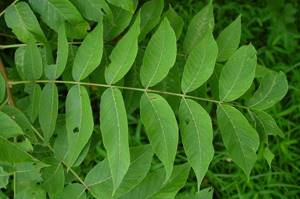
Fresh and dried leaves are used in the preparation of oral decoctions that successfully combat the following diseases:
- stomatitis;
- gingivitis;
- periodontal disease
Important! Doumbey nuts should not be eaten by animals, as this can lead to poisoning.
general characteristics
These trees are very tall, reaching about 30 meters in height. The walnut trunk is straight and quite wide, sometimes the diameter can reach 2 meters. The tree has a wide and spreading crown, and large leaves only add density. The peculiarity of the structure of the walnut root system is that it is powerful, has a strong and deep taproot, and a developed system of lateral branches. In adulthood, the radius of root growth can reach 20-30 meters, while the main root goes down to a depth of 7 meters. The color of the walnut bark is light gray, and the structure has small cracks.
The plant blooms in April. Female and male flowers are different; the latter are represented by oblong green catkins. Nuts live quite a long time: wild plants can live up to 1000 years, planted ones - up to 500.
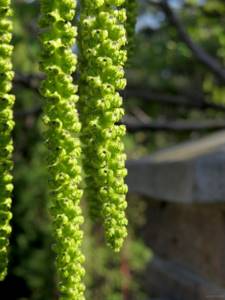
The natural habitat of the nut is Central Asia, but today this plant is planted all over the world: in Japan, China, India, the Caucasus, Greece, Ukraine, Western Europe. In Russian latitudes, in many regions it is cold for walnuts, but in the southern European part of the country walnuts are actively cultivated.

